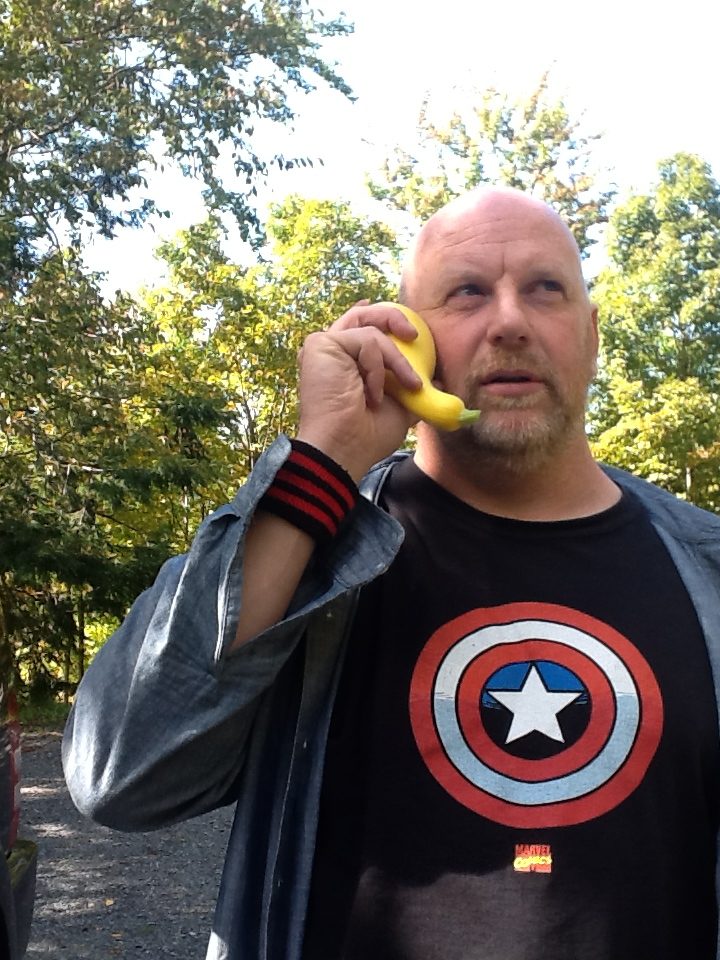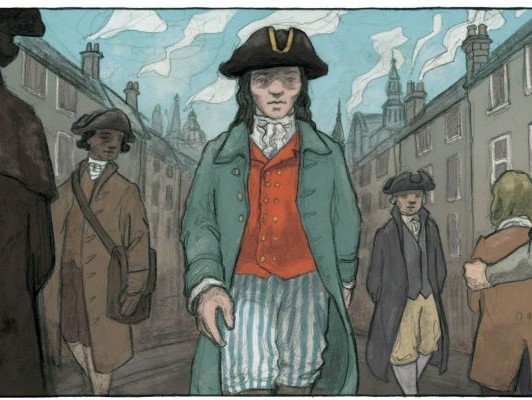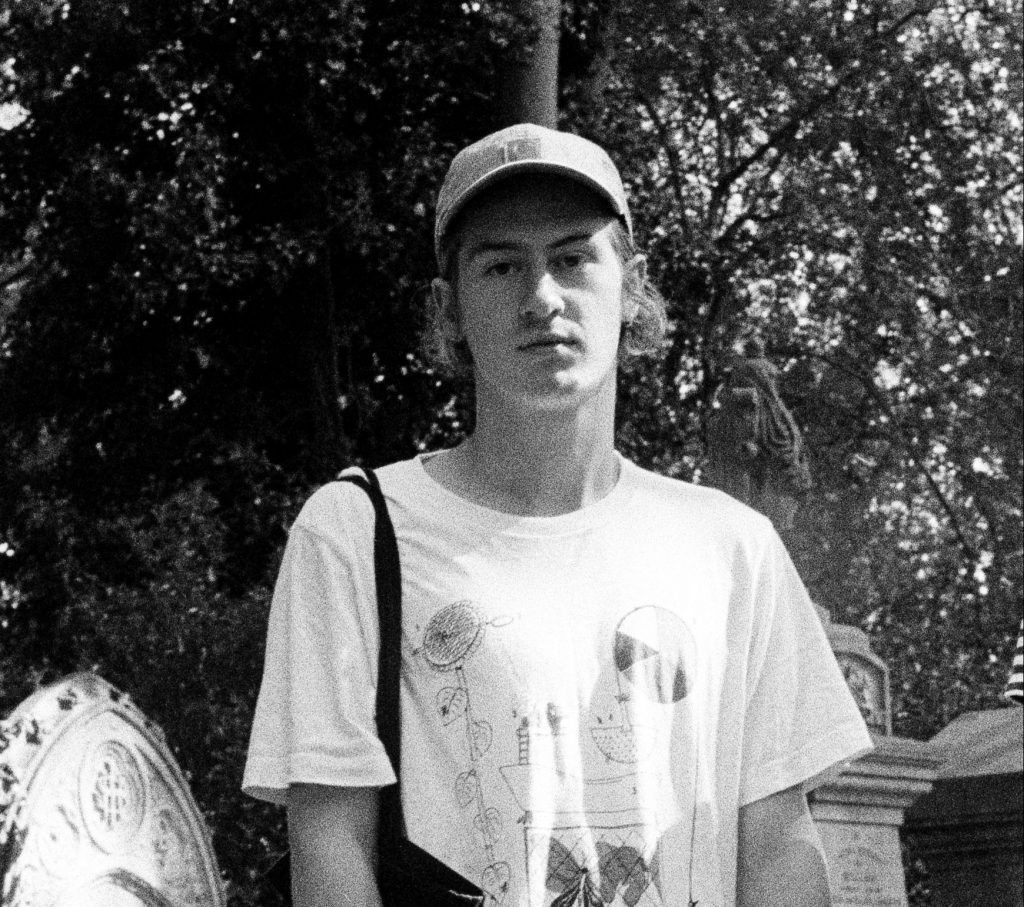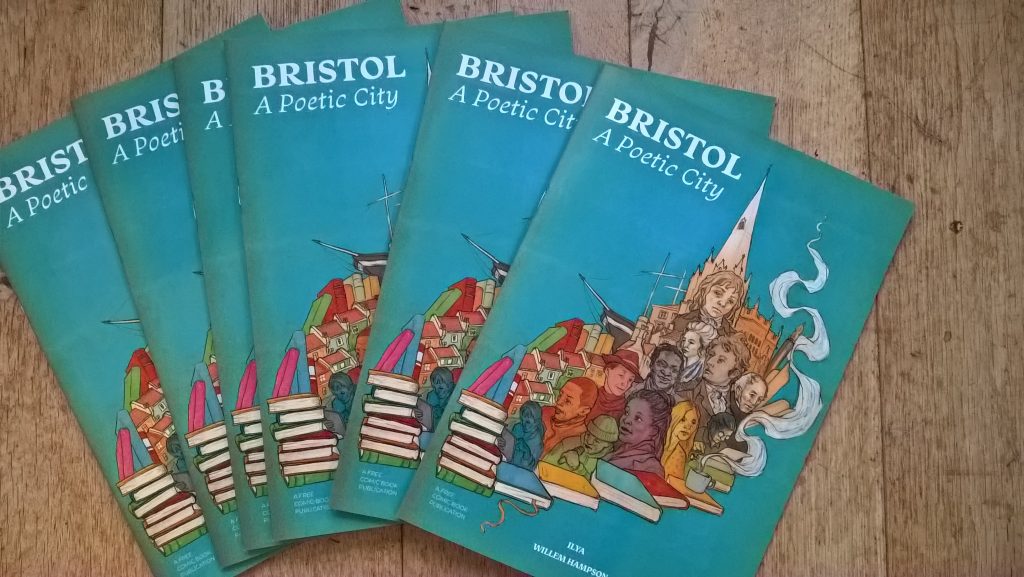
Poetic City Comic
The Poetic City comic-book telling the story of Thomas Chatterton’s life and legacy has now been published.
Copies will be available to collect for free from venues across the city including Bristol City Council’s libraries and museums; Bristol Cathedral; Glenside Hospital Museum; St Mary Redcliffe; the Tourist Information Centre at the Galleries; and the Royal West of England Academy. They have also been given to relevant departments at the University of Bristol and UWE Bristol to distribute to students and staff. (see the Poetic City Facebook page for the latest news on availability and the Poetic City page for details of other activities in this programme).
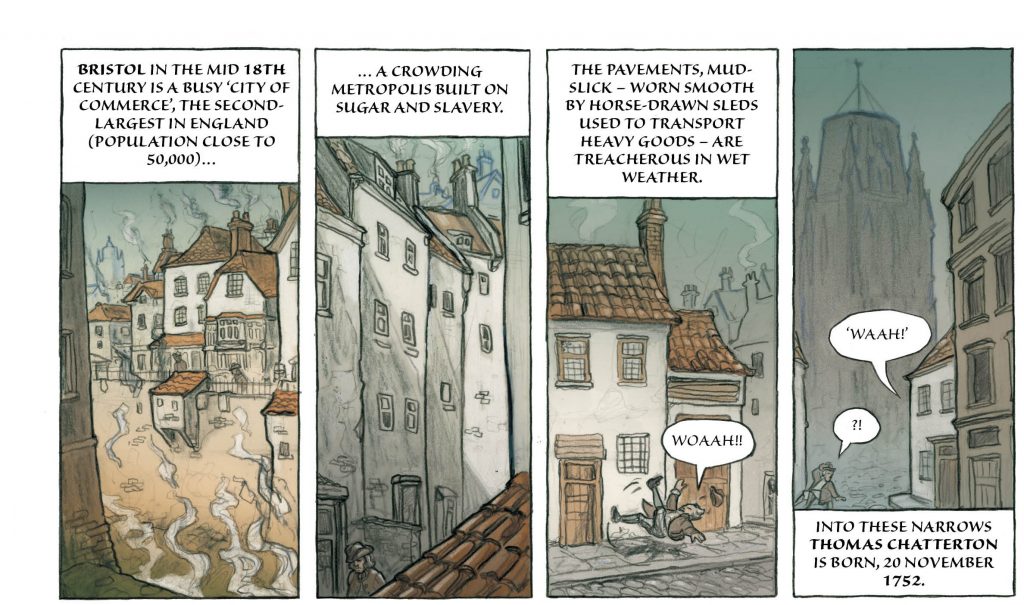
Interview/
The comic was written by ILYA and illustrated by Willem Hampson, both graduates from UWE. We asked them to reflect on their experience.
When the call for submissions for this project were announced, what sparked your interest?
ILYA: I knew the famous Death of Chatterton painting by Wallis (which, despite my cheeky remarks in the published comic, I do actually rate), and had even ‘quoted’ (swiped) it in a fully painted comic page that I’d created way back in the 1990s. So, although I wasn’t that familiar with his actual poetry, I knew who Chatterton was. He was part of the schools curriculum back in my day, mostly celebrated for having died so young – reduced to a symbol, or moral lesson, let’s say, more than a person.
I reckon my mum knew a bit more about his spirit and personality. I was a sharp kid, a precocious brat (infamously paraphrasing Wordsworth at just seven years old, which startled everyone), and she would call me her Chatterton, so I guess you could say I consciously identified. Mind you, having now researched and told his albeit short life story, I realise that her comparison wasn’t necessarily meant as a compliment!
Poetry and comics both deal in rhythm and meter, in terms of their pacing and delivery – the two art forms are more closely allied than many folks realise. I’ve always been interested in exploring that, having previously adapted a number of Shakespeare’s sonnets into comic strip format, and also, as a comics creator, collaborating a couple of times with living poets. In the end there wasn’t really sufficient room to explore much of that with this project – proper ‘poetry comics’ would require a great many more pages, for a start. But, in terms of subject matter, Chatterton’s life and times are a gift: one that I was happy to shoot for and then lucky enough to claim.
Willem: I had recently finished another historical illustration project based on the Newport Medieval ship in Wales. Working on that was a process I enjoyed greatly, delving in to an area of history with the assistance of enthusiasts and experts. I am always inspired by the visuals of a specific historical moment, the clothing, architecture, art, etc. I knew I wanted to continue in this vein of illustration and had also been eager to create a comic for a long time, being a fan of the medium but never having the source material or confidence to attempt one. Thomas Chatterton is a fascinating character marking an equally fascinating point in history and art; his work and influence meant I was able to draw from medieval art and later Romanticism, as well as eighteenth-century Bristol – these layers of visual inspiration really caught my attention.
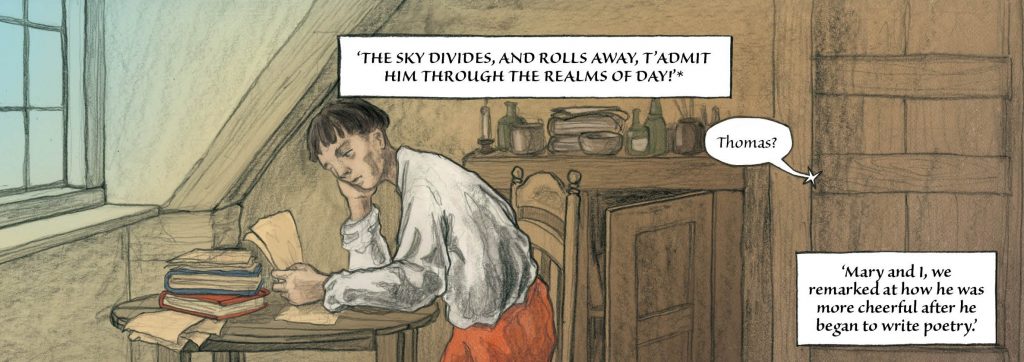
You were both students at UWE. How aware were you of Bristol’s poetic reputation at the time you were here? What are the most interesting things you have learnt about ‘the poetic city’ during the course of developing the comic?
ILYA: I studied Graphic Design at Bristol Polytechnic (before ‘university’ became more of a magic word), from 1983-86 (yes, I am as ancient as the hills). Then I lived another year or so in the city after my studies had ended because I liked it so much. As a Londoner, it was great to be able to enjoy the nightlife because it was relatively cheap, AND you could walk (or stagger) home afterwards. I got stuck into the cultural life for sure – Watershed, Arnolfini, gigs and comedy nights in the Thekla, the Old Vic, St Pauls festival, etc. etc. – but I can’t say that I especially knew the poetry scene or rep (although I’ve always liked poetry). Back then was the birth of The Wild Bunch et al, so perhaps it was that iteration of poetic and artistic expression – rap by the likes of Tricky, Bear Hackenbush’s Bugs and Drugs zines – that I was into more.
In terms of new learning, Bristol’s essential character as a mercantile ‘city of trade’ made the greatest impression – how that bled into the personalities of the people themselves, that Chatterton met. Hopefully this is made clear in the comic. That trade mentality also helped mould as well as frustrated him, too. He had to market himself and his art to get ahead, and that was a consistent theme that I could very much identify with, since it has become the chief characteristic of our own times – everything has a price, but without due care for or knowledge of the actual value of anything. It was inevitable really that Chatterton ultimately had to leave Bristol… he’d outgrown the limitations placed on him there. But still, he couldn’t necessarily escape them: not himself, his circumstances nor his own demons.
Willem: When I moved to Bristol I was immediately aware of its artistic and creative reputation, though I can’t claim I was particularly aware of its poetic one. The project gave me a much better insight in to that and it was compelling to discover the network of poetic connections to Bristol and Thomas Chatterton; from the eighteenth century right up until now. Discovering contemporary poets in Bristol was a real pleasure and whilst working on A Poetic City I got through a lot of brilliant listening material from the likes of Miles Chambers, Vanessa Kisuule, Lawrence Hoo and more.
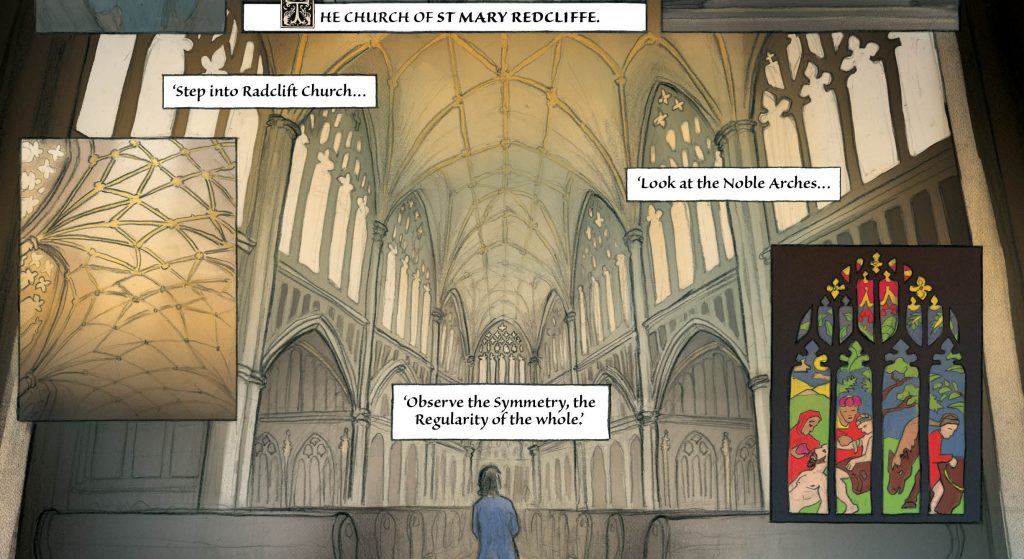
You’ve had to manage this new collaboration under lockdown conditions. What challenges did you face in terms of undertaking research and developing a partnership approach? What did you think worked well in these unusual circumstances?
ILYA: It was frustrating not to be able to visit Bristol itself (I live and work in London): not soak up sheer atmosphere at sites like St Mary Redcliffe – spirit memory, encoded in the bricks and mortar in all the places that Chatterton would have frequented. Luckily I both knew and recalled those environs well from my time there. And I could rely on my collaborator, Willem, to bring much of that feel across in the images I was asking for. I couldn’t do my researches in the likes of the British Library, either, which would normally be enriching deep fun to me, worthy of any excuse (It is always best to return to original sources, as far as it’s possible: you always pick up on nuances and make connections that others might have missed within their secondary resources).
But, I was glad to have the work, at a time when so many others in my field saw theirs dry up. Lockdown conditions are fairly normal for us both, shut in working hard on any project – and yet the stress is in the air all the same. So much remains uncertain.
The other bind was that Willem and I could not (and have not yet) met face to face. Screen talks and constant texting back and forth became essential to our close collaboration. The project would have been dead without that. And yet remote access will always be a poor substitute for actions and words IRL, in real life – at least to an old dog like me. We’re both of us strong-willed and proud of our art, so there had to be a little bit of back and forth, territorial marking, at the very beginning. That convinced me, more than anything, we were the right ones for the job. We understood one another, properly respected each other’s input, and worked very well together. There’s more than a little of Chatterton in each of us.
Willem: I don’t know how different the project would have been for me without lockdown conditions. In normal circumstances I can often finish a project having only ever spoken to someone online. Having said that, I would have wanted to be more hands-on in the research stage, with visits to Bristol to collect my own material in the form of drawings and photo’s. Luckily I was regularly provided with brilliant material by several others working on A Poetic City.
With something as collaborative as this it would have been helpful to meet certain people face-to-face, especially ILYA. It took a week or so but once we figured out our working dynamic it was pretty seamless and we managed fine with video calls and emails. It didn’t provide much of a barrier in the end and I really enjoyed working with him in this way. I think we are both people that love what we do and care about the final product so it was a real pleasure to have that shared enthusiasm. He’s also got years of experience on me so it was a great learning curve working with a comics veteran. I look forward to the day we can actually meet and talk comics. Looking back, the project was impressively well run despite the difficult circumstances, the project manager, Mel Kelly, definitely held us together!
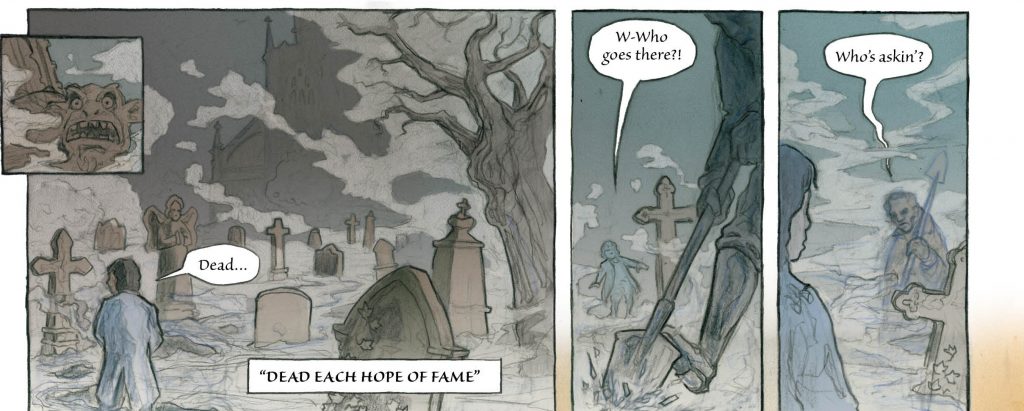
What do you hope readers will gain from reading your comic?
ILYA: Comics should always be entertaining and enlightening, but also provoking – I hope it does all three things. It’s not an immediate prospect: a young poet dead 250 years. Nor, for many, is poetry itself immediately attractive. Chatterton’s own writings can be difficult. They no longer communicate so very easily to us. But there’s a lot of content in there that echoes – his youth, his spite, his struggle, his wit, his smarts. Successive philistine governments mean the arts and humanities are no longer much valued, funded or respected, when we need them the most. So I hope readers find Chatterton’s story unexpectedly funny, shocking, inspiring, enraging, or at least engaging. It helps greatly that the comic can be given away free. Again, in our mercantile society, this might be perceived by some as a weakness – ‘What value can it have if they’re giving it away? It can’t be any good’. But, if you come out of it with your mind changed in some way, then that makes the experience of reading the comic and a short while’s communion with Chatterton truly priceless.
Willem: The audience should be a broad one, given that the comic will be free and distributed across a variety of venues. I hope this will result in more people engaging with the comic medium. If this is the first comic they read, I hope they enjoy it enough to go away and pick up some more. Hopefully we also generate more interest in Chatterton. He is a mysterious and complex character, with an amazing legacy. As mentioned before, discovering Bristol’s contemporary poets was a joy for me and I hope this is the case for others who read the publication.
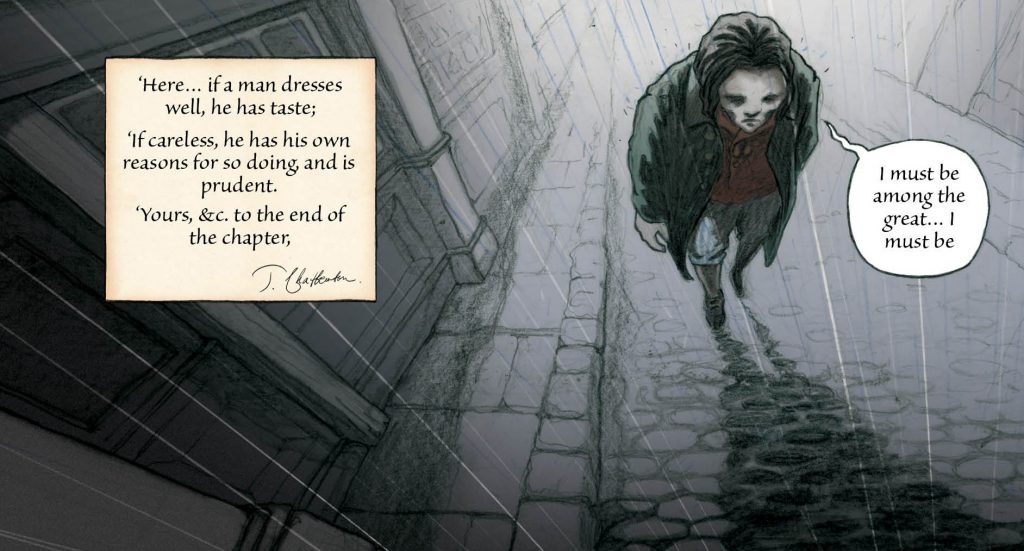
What projects are you currently working on or have planned for the future?
ILYA: I helped create another free giveaway comic last year, Time Traveller, about the little known father of cinema – and a visionary of virtual reality in 1895 – called Robert Paul. You can read that online here: TIME TRAVELLER. A tie-in exhibition should continue touring nationwide once Covid restrictions can be lifted.
I have a regular Cartoon History slot – usually four pages – in every other issue of the New Internationalist. It’s more comics biography really, as with Paul and Chatterton. My latest and ninth feature, just out in issue 527, tells the story of Minik Wallace – an Inuit (‘eskimo’) brought to New York as a boy, back in 1897, who then found his father’s remains on display in the city museum. It’s a real horror show.
I’ve recently completed my second prose novel, the first in a possible series about survival in a near future USA. That’s called A Circle Squared, and I’m hoping soon to find for it both representation and a publisher.
Next up on the drawing (and writing) board? A hush-hush (for now) personal project in a comic strip format blended with prose – something that, if I can make a success of it, I hope will go on to become my magnum opus. So wish me luck!
Willem: I’m currently working at an artists residency. Unfortunately this is not in a particularly creative capacity but it’s given me a lot of perspective to be amongst artists from different disciplines and at various stages in their careers. I would like to continue working collaboratively with people, and I would like to make more comics/graphic novels. I enjoyed reading them before this project, but it allowed me to delve in to the medium in a new way and I have become a bit obsessed in the process. The current plan is to begin a comic book project when I leave the residency, and to continue work as a freelance illustrator alongside that. I’d also like to commit more time to drawing and painting for myself, not only commissions. My plans don’t go much further than that at the moment.
This interview was first published on 6 October 2020.
Poetic City Comic PDF
If you are unable to obtain a printed copy of the comic, you can download a PDF version here (file size 14MB).
The Poetic City programme is funded thanks to grants awarded by the National Lottery Heritage Fund, using money raised by National Lottery players.
